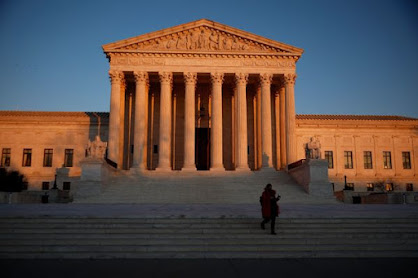Expanding the Supreme Court?

Article III, Section 1 of the
Constitution
gives Congress the authority to change the size of the Supreme Court. Congress
has used that authority seven times before. To restore balance and integrity to
a broken institution, Congress must expand the Supreme Court by four or more
seats
Leftists' work to grow the
number of judges on the Supreme Court faces slim chances in Congress. Leftists
have acquainted a bill with growing the number of judges on the Supreme Court
from nine to 13. Such a move could permit President Biden to swing the ongoing
6-3 moderate larger part for nonconformists.
The work, denounced by
Republicans, faces one in a million chances and has brought up issues about why
the issue is being raised now and what Congress can really do. Liberals say it
is because of Senate GOP pioneer Mitch McConnell. Right on time in 2016, McConnell
hindered hearings or a decision on Judge Merrick Garland, President Obama's
chosen one to fill the seat left by the unexpected passing of moderate Justice
Antonin Scalia.
McConnell expressed that in a
political decision year, the citizens ought to conclude who will pick the
following equity. At the point when Donald Trump was chosen, he picked Scalia's
substitution. Be that as it may, late in 2020, when liberal Justice Ruth Bader
Ginsburg kicked the bucket, McConnell hurried through one more Trump-chosen one
to fill her seat seven days before the political race which was won by Joe
Biden. The Republicans took two seats on the Supreme Court, and presently it
really depends on us to fix that harm,
Might Congress at any point
change the number of seats on the high court? Indeed. The Constitution passes
on this choice to Congress. According to it, "the legal force of the
United States will be vested in one Supreme Court and in such second rate
courts as the Congress may every once in a while appoint and layout." And
occasionally, Congress has for sure changed the number of judges. It was six
when Congress passed the main Judiciary Act in 1789 and the number changed
during the nineteenth hundred years. Yet, starting around 1869, the high court
had nine judges.
In 1937, subsequent to
winning an avalanche re-appointment, President Franklin D. Roosevelt said the
Supreme Court judges were old and exhausted, and he proposed to add one new
equity for each ongoing equity over age 70. This might have extended the court to
15 judges. Yet, everybody grasped FDR's actual thought process. He was furious
with the old moderate judges who had struck down a few of his New Deal measures
intended to adapt to the Great Depression. They had a "pony and
buggy" perspective on the Constitution, he told journalists. In spite of
colossal Democratic larger parts, the House and Senate made no move on FDR's
arrangement. However, in the spring, the Supreme Court seemed to take an
alternate route. A thin greater part maintained a New Deal measure to safeguard
laborers and associations as well as regulations setting least wages. It was
named "the switch in time that saved the nine."
What's more, inside a couple
of years, FDR had pressed the court as it was done in the good 'ol days. As the
old judges resigned, he supplanted every one of them with New Deal dissidents.
Since it would take four new Democrats to make a liberal greater part. With the
appearance of 49-year-old Justice Amy Coney Barrett, the court has six
Republican nominees who incline right, and three Democratic deputies who lean
on the left. The oldest of the nine is liberal Justice Stephen G. Breyer, who
is 82. He is supposed to resign this year or next, permitting President Biden
to fill his seat. Yet, Republican representatives seek to hold a
disproportionate greater part for one more ten years or more, excepting an
emotional change.
Biden said he loves court
pressing and picked to set up a 36-part commission to endure a half year
contemplating potential changes or changes to the Supreme Court. Also, House
Speaker Nancy Pelosi (D-San Francisco) said she was not enthused about the
extension bill. Leftists would likewise first need to cancel the delay rule in
the Senate to get an opportunity to pass his court development bill. Furthermore,
all things considered, it would require each of the 50 Democrats to cast a
ballot in favor.
In the event that Democrats
prevailed with regards to expanding the number of judges, how might Republicans
respond? They say they would do likewise when they recaptured full control of
Congress and the White House, and change the number of seats to either add
judges or decrease the number in the event that a Democratic nominee resigned
or kicked the bucket. One well-known proposition would restrict the judges to
an 18-year term, and have a president choose another equity-like clockwork.
This would enjoy a few benefits. It would permit every president to delegate
two judges in a four-year term, and it would end the impetus to pick ever more
youthful judges in the expectation they could serve in a strong situation for
30 or 40 years. Be that as it may, the Constitution might be revised, since it
says judges and judges, once delegated, "will hold their workplaces during
appropriate conduct." What do Republicans and traditionalists think about
the proposed extension? Of course, a large portion of them reproves it as a
horrible thought.
Be that as it may, a few
moderate examiners stress over FDR's point of reference for an alternate
explanation. They trust the Supreme Court will use its strong moderate larger
part to roll out significant improvements in the law on issues like fetus
removal, religion, and weapons. What's more, they dread a few judges might
conclude this present time isn't the opportunity for a moderate upset inside
the court.


Comments
Post a Comment